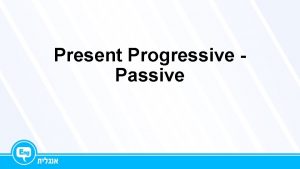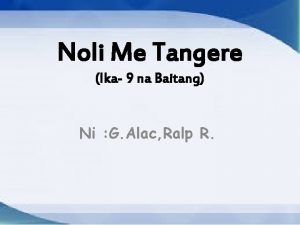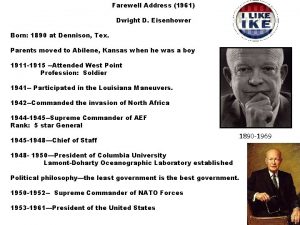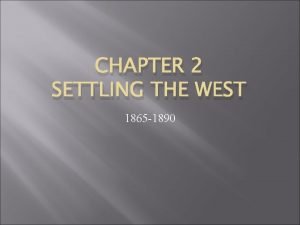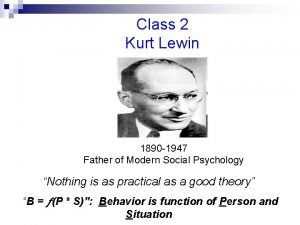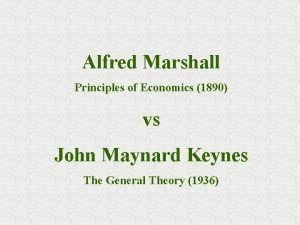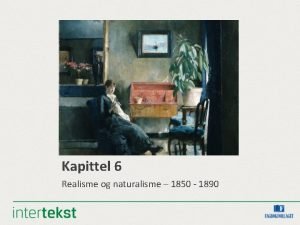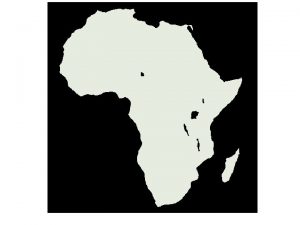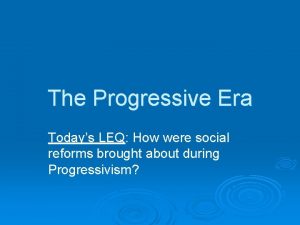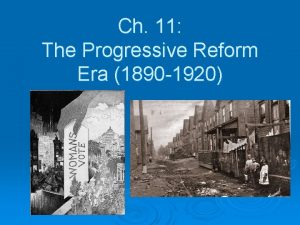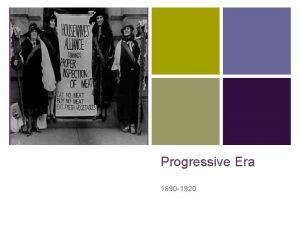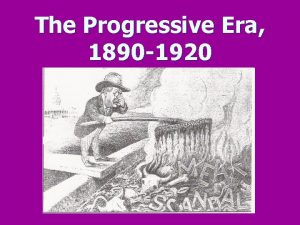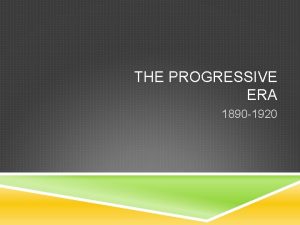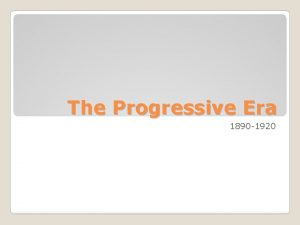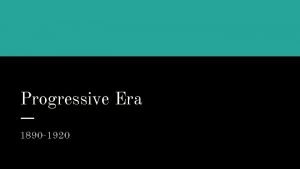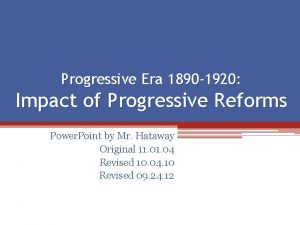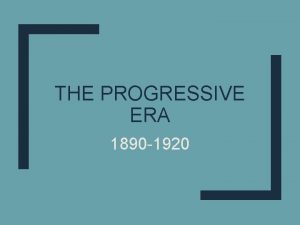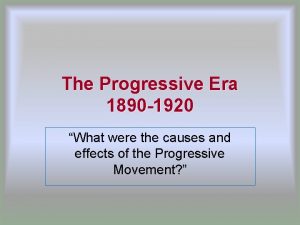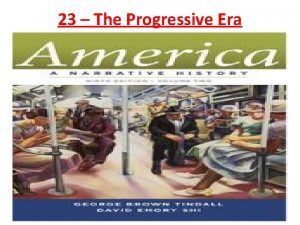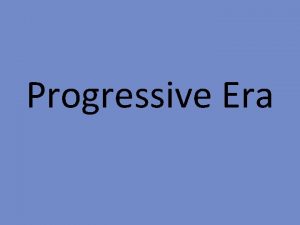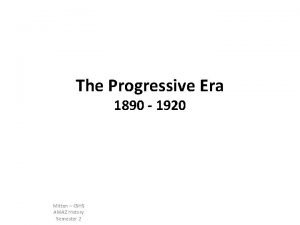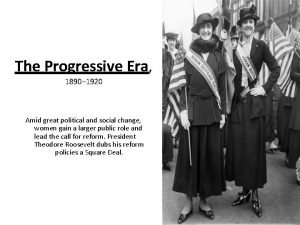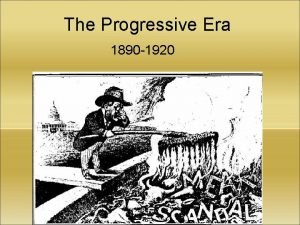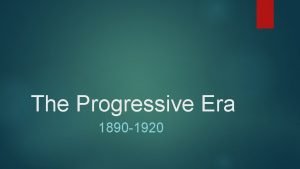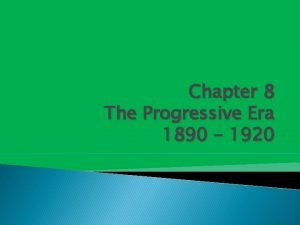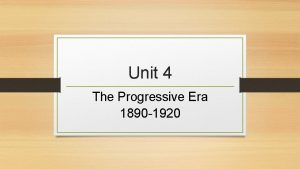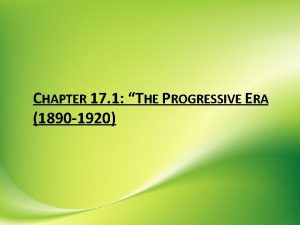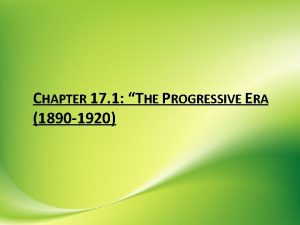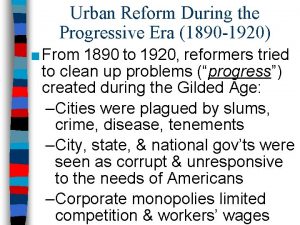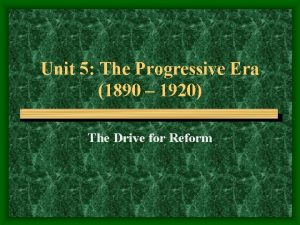The Progressive Era 1890 1920 What were the






















- Slides: 22

The Progressive Era 1890 -1920

What were the issues of the Gilded Age? Disparity of wealth Working conditions Wages, hours, child labor, danger, etc. Poverty in cities – Tenements, poor sanitation Discrimination – Immigrants & African Americans Social Gospel-Social Justice Immigrants, Women, African Americans, Children

Social Justice Improve working conditions in industry, regulate unfair business practices, eliminate child labor, help immigrants and the poor

Political Democracy Give the government back to the people, get more people voting and end corruption with political machines.

Economic Justice • Fairness and opportunity in the work world, regulate unfair trusts and bring about changes in labor. • Demonstrate to the common people that U. S. Government is in charge and not the industrialists.

CONSERVATION Preserve natural resources and the environment

Reformer or Organization Problem Reforms/Changes (What did they do? ) Issue—Social, Political or Economic Muckraker Corrupt business practices; corrupt politicians-political machines and ‘bosses’; poor immigrants-bad living conditions; A group of writers that exposed corruption in the US. They created a public demand for reform. Political, social, economic Upton Sinclair Gruesome conditions in the meat packing industry Wrote a book—The Jungle which brought the problem to the attention of President T. Roosevelt. Led to the passage of the Meat Inspection Act and the Pure Food and Drug Act. Social and economic Thomas Nast political machines and ‘bosses’like William ‘Boss’ Tweed’ Drew political cartoons cartoonist that poked fun at politics Political Ida Tarbell Unfair business tactics—trusts and monopoly a muckraker who accused Standard Oil for unfair tactics to force small companies out of business Political, economic Robert La. Follette Closed political process-not open to all Americans. governor of Wisconsin that became the first state to establish a direct primary. A direct primary is when VOTERS, not conventions, choose the candidates to run for office. political

What is a muckraker? Writer/journalist who exposes the problems of society in order to bring about reform

Muckrakers Lincoln Steffens (magazine editor) The Shame of the Cities Political corruption in Philadelphia Link between big business and crooked politicians Jacob Riis (photographer, NY Evening Sun) How the Other Half Lives Poor living conditions in tenements





Lewis Hine and Child Labor Lewis Hine was a school teacher turned muckraker A photographer interested in exposing the problems of society. 1908 -1912 showed the abuses of child labor Created photo essay on child labor in 1909

Muckrakers Upton Sinclair The Jungle Working conditions for immigrants; unsanitary conditions in meat-packing plants Frances E. W. Harper Iola Leroy Struggles of African Americans



Who opposed discrimination, and how? Ida B. Wells Worked to stop lynching National Association of Colored Women http: //withoutsanctuary. org/ma in. html “Brave men do not gather by thousands to torture and murder a single individual, so gagged and bound he cannot make even feeble resistance or defense. ”

• Thomas Nast was a political cartoonist who worked for a magazine called Harpers Weekly. • Nast is often spoken of as “the first great American cartoonist. . . many of his symbols and devices have become part of the cartoonist's stock in trade. ” Artist’s self-caricature

Thomas Nast popularized the elephant as the symbol for Republicans and the donkey as the symbol for Democrats.

“Boss” Tweed ØThomas Nast criticized “Boss” Tweed, a crooked New York City politician ØFor Nast, Tweed personified two great evils afflicting American society after the Civil War: corruption and greed ØCartoon after cartoon pictured Tweed as a thief ØTweed lost political power and was convicted of corruption

Wrapup 1. What were the goals of Progressives during this era? 2. Name three key problems facing the nation during this time period. 3. What is a muckraker and what do they have to do with the Progressive Era? 4. Name two significant muckrakers and the issues they exposed.
 Progressive passive
Progressive passive Perfectits
Perfectits Function of past continuous tense
Function of past continuous tense Talata tungkol sa noli me tangere
Talata tungkol sa noli me tangere 1890'lı yıllarda ingiltere'de whiff
1890'lı yıllarda ingiltere'de whiff 1890 computer
1890 computer Kirjanik 1886-1971
Kirjanik 1886-1971 Born 1890
Born 1890 The population of smallville in the year 1890 was 6250
The population of smallville in the year 1890 was 6250 Settling the west 1865 to 1890
Settling the west 1865 to 1890 Agnosia cromatica
Agnosia cromatica Kaligirang pangkasaysayan ng el fili
Kaligirang pangkasaysayan ng el fili Exponential functin
Exponential functin Rizal left london and went to paris.
Rizal left london and went to paris. Kurt lewin (1890-1947)
Kurt lewin (1890-1947) Keynes marshall
Keynes marshall Albertine litterær periode
Albertine litterær periode Africa 1890
Africa 1890 Paghahambing sa layunin ng pagsulat personal at sosyal
Paghahambing sa layunin ng pagsulat personal at sosyal What does glinda the good witch represent in populism
What does glinda the good witch represent in populism Initiative progressive era definition
Initiative progressive era definition Progressive era leq
Progressive era leq Chapter 11 the progressive reform era
Chapter 11 the progressive reform era
